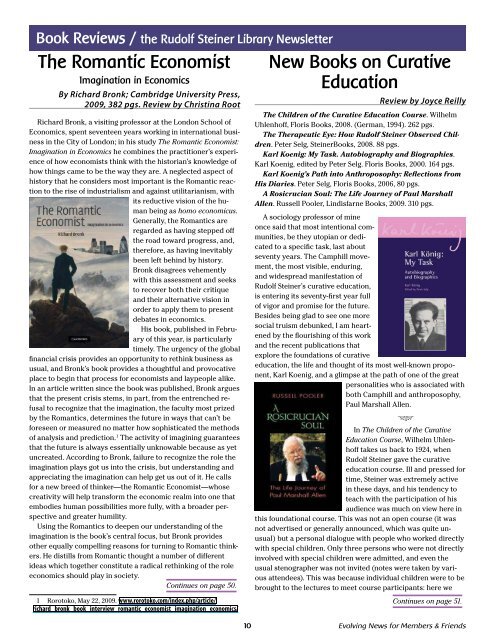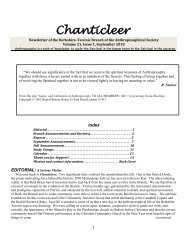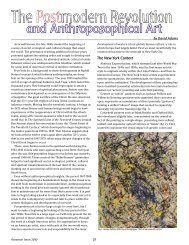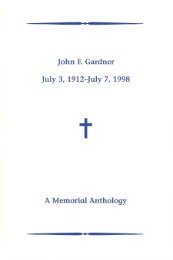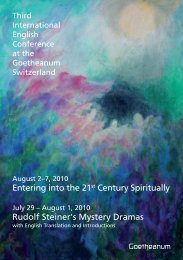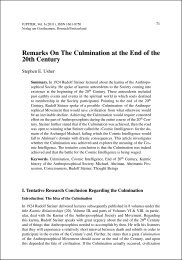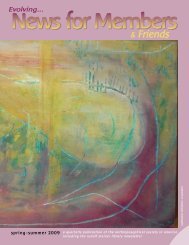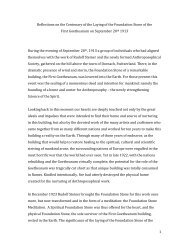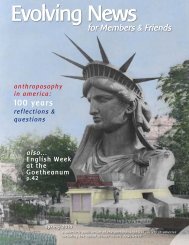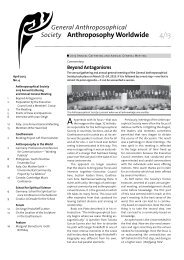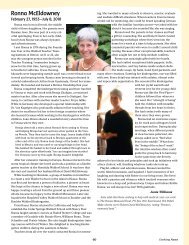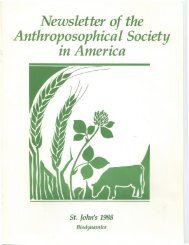& Friends - Anthroposophical Society in America
& Friends - Anthroposophical Society in America
& Friends - Anthroposophical Society in America
Create successful ePaper yourself
Turn your PDF publications into a flip-book with our unique Google optimized e-Paper software.
Book Reviews / the Rudolf Ste<strong>in</strong>er Library NewsletterThe Romantic EconomistImag<strong>in</strong>ation <strong>in</strong> EconomicsBy Richard Bronk; Cambridge University Press,2009, 382 pgs. Review by Christ<strong>in</strong>a RootRichard Bronk, a visit<strong>in</strong>g professor at the London School ofEconomics, spent seventeen years work<strong>in</strong>g <strong>in</strong> <strong>in</strong>ternational bus<strong>in</strong>ess<strong>in</strong> the City of London; <strong>in</strong> his study The Romantic Economist:Imag<strong>in</strong>ation <strong>in</strong> Economics he comb<strong>in</strong>es the practitioner’s experienceof how economists th<strong>in</strong>k with the historian’s knowledge ofhow th<strong>in</strong>gs came to be the way they are. A neglected aspect ofhistory that he considers most important is the Romantic reactionto the rise of <strong>in</strong>dustrialism and aga<strong>in</strong>st utilitarianism, withits reductive vision of the humanbe<strong>in</strong>g as homo economicus.Generally, the Romantics areregarded as hav<strong>in</strong>g stepped offthe road toward progress, and,therefore, as hav<strong>in</strong>g <strong>in</strong>evitablybeen left beh<strong>in</strong>d by history.Bronk disagrees vehementlywith this assessment and seeksto recover both their critiqueand their alternative vision <strong>in</strong>order to apply them to presentdebates <strong>in</strong> economics.His book, published <strong>in</strong> Februaryof this year, is particularlytimely. The urgency of the globalf<strong>in</strong>ancial crisis provides an opportunity to reth<strong>in</strong>k bus<strong>in</strong>ess asusual, and Bronk’s book provides a thoughtful and provocativeplace to beg<strong>in</strong> that process for economists and laypeople alike.In an article written s<strong>in</strong>ce the book was published, Bronk arguesthat the present crisis stems, <strong>in</strong> part, from the entrenched refusalto recognize that the imag<strong>in</strong>ation, the faculty most prizedby the Romantics, determ<strong>in</strong>es the future <strong>in</strong> ways that can’t beforeseen or measured no matter how sophisticated the methodsof analysis and prediction. 1 The activity of imag<strong>in</strong><strong>in</strong>g guaranteesthat the future is always essentially unknowable because as yetuncreated. Accord<strong>in</strong>g to Bronk, failure to recognize the role theimag<strong>in</strong>ation plays got us <strong>in</strong>to the crisis, but understand<strong>in</strong>g andappreciat<strong>in</strong>g the imag<strong>in</strong>ation can help get us out of it. He callsfor a new breed of th<strong>in</strong>ker—the Romantic Economist—whosecreativity will help transform the economic realm <strong>in</strong>to one thatembodies human possibilities more fully, with a broader perspectiveand greater humility.Us<strong>in</strong>g the Romantics to deepen our understand<strong>in</strong>g of theimag<strong>in</strong>ation is the book’s central focus, but Bronk providesother equally compell<strong>in</strong>g reasons for turn<strong>in</strong>g to Romantic th<strong>in</strong>kers.He distills from Romantic thought a number of differentideas which together constitute a radical reth<strong>in</strong>k<strong>in</strong>g of the roleeconomics should play <strong>in</strong> society.Cont<strong>in</strong>ues on page 50.1 Rorotoko, May 22, 2009. www.rorotoko.com/<strong>in</strong>dex.php/article/richard_bronk_book_<strong>in</strong>terview_romantic_economist_imag<strong>in</strong>ation_economics/New Books on CurativeEducationReview by Joyce ReillyThe Children of the Curative Education Course. WilhelmUhlenhoff, Floris Books, 2008. (German, 1994). 262 pgs.The Therapeutic Eye: How Rudolf Ste<strong>in</strong>er Observed Children.Peter Selg, Ste<strong>in</strong>erBooks, 2008. 88 pgs.Karl Koenig: My Task. Autobiography and Biographies.Karl Koenig, edited by Peter Selg. Floris Books, 2000. 164 pgs.Karl Koenig’s Path <strong>in</strong>to Anthroposophy: Reflections fromHis Diaries. Peter Selg, Floris Books, 2006, 80 pgs.A Rosicrucian Soul: The Life Journey of Paul MarshallAllen. Russell Pooler, L<strong>in</strong>disfarne Books, 2009. 310 pgs.A sociology professor of m<strong>in</strong>eonce said that most <strong>in</strong>tentional communities,be they utopian or dedicatedto a specific task, last aboutseventy years. The Camphill movement,the most visible, endur<strong>in</strong>g,and widespread manifestation ofRudolf Ste<strong>in</strong>er’s curative education,is enter<strong>in</strong>g its seventy-first year fullof vigor and promise for the future.Besides be<strong>in</strong>g glad to see one moresocial truism debunked, I am heartenedby the flourish<strong>in</strong>g of this workand the recent publications thatexplore the foundations of curativeeducation, the life and thought of its most well-known proponent,Karl Koenig, and a glimpse at the path of one of the greatpersonalities who is associated withboth Camphill and anthroposophy,Paul Marshall Allen.••In The Children of the CurativeEducation Course, Wilhelm Uhlenhofftakes us back to 1924, whenRudolf Ste<strong>in</strong>er gave the curativeeducation course. Ill and pressed fortime, Ste<strong>in</strong>er was extremely active<strong>in</strong> these days, and his tendency toteach with the participation of hisaudience was much on view here <strong>in</strong>this foundational course. This was not an open course (it wasnot advertised or generally announced, which was quite unusual)but a personal dialogue with people who worked directlywith special children. Only three persons who were not directly<strong>in</strong>volved with special children were admitted, and even theusual stenographer was not <strong>in</strong>vited (notes were taken by variousattendees). This was because <strong>in</strong>dividual children were to bebrought to the lectures to meet course participants: here weCont<strong>in</strong>ues on page 51.10 Evolv<strong>in</strong>g News for Members & <strong>Friends</strong>


